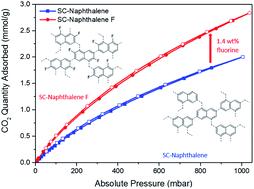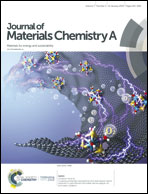Post-synthetic fluorination of Scholl-coupled microporous polymers for increased CO2 uptake and selectivity†
Abstract
We report a facile, one-step post-synthetic fluorination method to increase the CO2 capacity and CO2/N2 selectivity of porous organic Scholl-coupled polymers. All of the fluorinated polymers that we synthesised showed increases in CO2/N2 IAST selectivity and CO2 isosteric heat; almost all materials also showed an increase in absolute CO2 uptake. Our best-performing material (SC-TPB F) demonstrated a CO2 capacity and CO2/N2 selectivity of 3.0 mmol g−1 and 26 : 1, respectively, at 298 K—much higher than the corresponding non-fluorinated polymer, SC-TPB. This methodology might also be applicable to other polymer classes, such as polymers of intrinsic microporosity, thus providing a more general route to improvements in CO2 capacity and selectivity.

- This article is part of the themed collection: 2019 Journal of Materials Chemistry A HOT Papers


 Please wait while we load your content...
Please wait while we load your content...